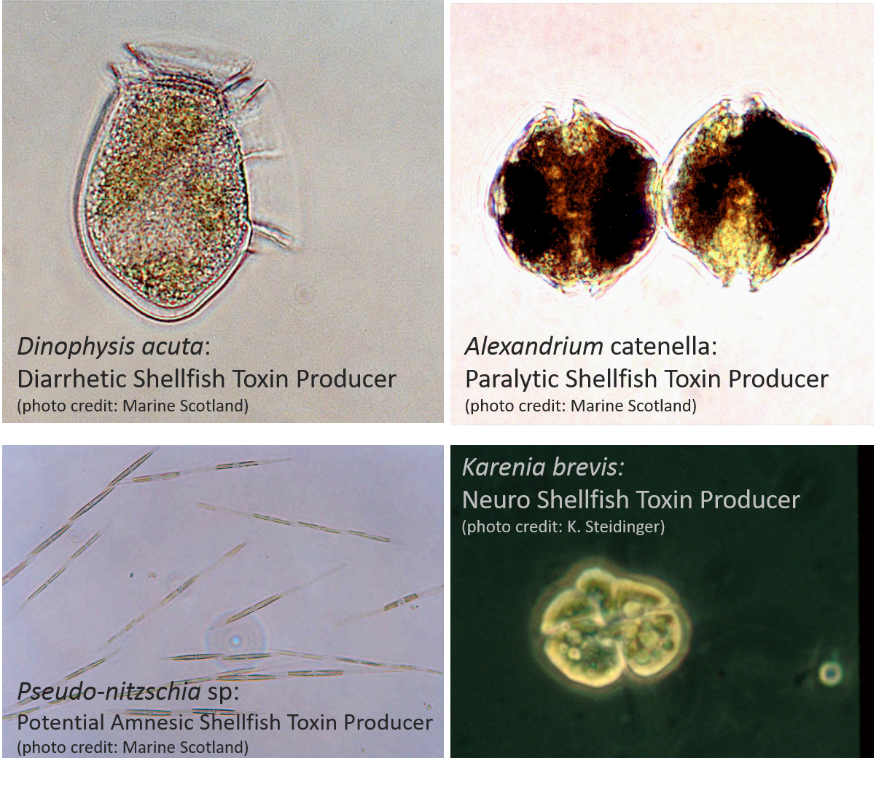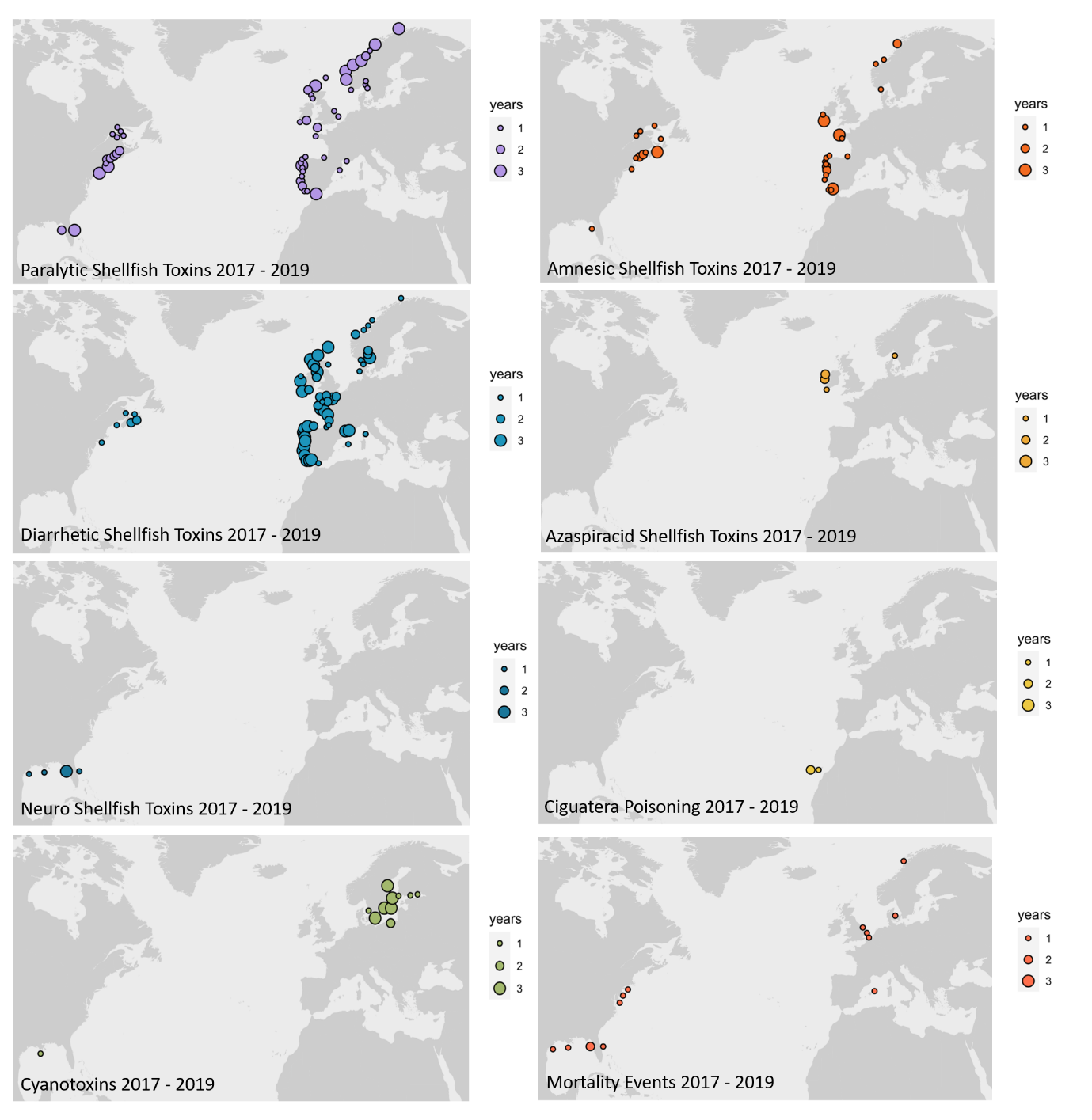Harmful algal blooms (HABs) impact marine ecosystems, aquaculture, and tourism industries, and can pose a risk to human health across the world. Within ICES region, the impacts of HABs are recorded on an annual basis. The most frequently recorded HAB events are closures of shellfish harvesting areas due to the accumulation of algal toxins in marine bi-valve molluscs exceeding regulatory thresholds. Additionally, mortalities of farmed and wild fish, benthic organisms, sea birds, and mammals can also be recorded. Water discolurations, scums, and foams can also cause problems for local tourism industries with some high biomass algal blooms resulting in mortalities of wild and farmed fish, and benthic organisms through the generation of anoxia.
First global status report on HAB events
The Intergovernmental Oceanographic Commission (IOC) of UNESCO has just published the first Global HAB Status Report (GHSR). The aim of this report is to provide the first assessment of the status of HABs around the world and look for the presence of global trends.
The study found that reported HAB events have increased in some regions and decreased or stabilised in others. This variability in regional trends was driven by differences in bloom species, type, and emergent impacts. A widely-stated view that HABs are on the rise, perhaps due to climate change, throughout the world is not confirmed. Instead, trends in HAB events need to be considered regionally, and at the species level to identify drivers at a more local scale. Regional assessments point at intensified monitoring efforts associated with increased aquaculture production and tourism, being responsible for the perceived increase in harmful algal events.
The full Global HAB Status Report consists of:
- "Perceived global increase in algal blooms is attributable to intensified monitoring and emerging bloom impacts" published in the Nature journal Communications Earth & Environment
- Special issue of the Elsevier journal 'Harmful Algae'
Open access to key papers. - Global HAB Status Report Synthesis and Scientific Summary for Policy Makers
- The Harmful Algal Information System (HAIS) Data Portal
- Press release
A special issue of the journal
Harmful Algae, published in February 2021 for the GHSR, contains regional overviews of HAB events from around the world. Members of ICES-IOC Working Group on Harmful Algal Bloom Dynamics (
WGHABD) have contributed five papers to this special issue using the IOC-ICES-PICES Harmful Algal Event Database (
HAEDAT) to generate a baseline of HAB events since the 1990s from France, the Atlantic margin of Europe, Northern Europe, the USA, and Canada. This information is needed to interpret changes in the occurrence of HAB events over time, and develop future adaptation and mitigation strategies to reduce impacts on the marine ecosystem, industries, and society.

Toxin producing HAB species from ICES area.
HAB events in ICES area
The majority of HAB events in ICES area are closures of shellfish harvesting areas due to algal toxins above regulatory levels. Multiple algal toxins produced by different genera and species of phytoplankton are responsible:
- Paralytic Shellfish Toxins have the main impact on shellfish harvesting areas along the east coast of the USA and Canada and are regionally variable in Europe. They have also been responsible for mammal mortalities in some areas;
- Diarrhetic Shellfish Toxins have the most impact on the shellfish industry in Europe and have recently begun to cause closures of harvesting areas on the east coast of the USA;
- Impacts from Amnesic Shellfish Toxins are more variable in Europe and Canada. Recently these toxins have begun to impact the east coast of the USA;
- Neuro Shellfish Toxins have caused shellfish harvesting closures, mass mortalities of shellfish, fish, birds, and mammals, and impacted tourism in the Gulf of Mexico and Florida. No impacts from these toxins have been recorded in Europe;
- The majority of events causing shellfish production area closures associated with Azaspiracids continue to be recorded in Ireland.
There are other significant HAB events in ICES area:
- Ciguatera poisoning has become an endemic problem in Europe, posing a risk to human health in the Canary Islands since 2004 with records also from the Selvagens Islands and the Madeira archipelago;
- Mortalities of farmed fish due to HABs have been recorded throughout the ICES area with recent events in Northern Europe resulting in large economic losses;
- Cyanobacterial blooms mainly cause problems in the brackish waters of the Baltic Sea area with particular impacts on tourism and recreational activities.
WGHABD
Henrik Enevoldsen, IOC of UNESCO and WGHABD, spoke to BBC Inside Science last week about the report (
interview begins at 16:10) about the future of HAB events, "We expect that some of that [impact of HAB events] can be mitigated by better monitoring and then you will see fewer human health impacts, but there may still be a high number of events in terms of closing fisheries, closing of harvesting, and then the economic impact. So it's really this preventing, controlling, mitigation that is the key to bringing down the impact of this at regional and local scale".
Ask the experts
Along with Enevoldsen, members of WGHABD–Eileen Bresnan, Marine Scotland, UK, Don Anderson, Woods Hole Oceanographic Institution, US, Bengt Karlson, Swedish Meteorological and Hydrological Institute, and Cynthia McKenzie, Fisheries and Oceans Canada–will be participating in a live webinar on the GHSR, hosted by the IOC on Tuesday 15 March 2021 at 13:00 CET.

Maps using HAEDAT data showing the regional distribution of different HAB events in ICES area. Data from 2017–2019 is shown here. The circles represent the number of years with events in each HAEDAT area. Click to enlarge.

